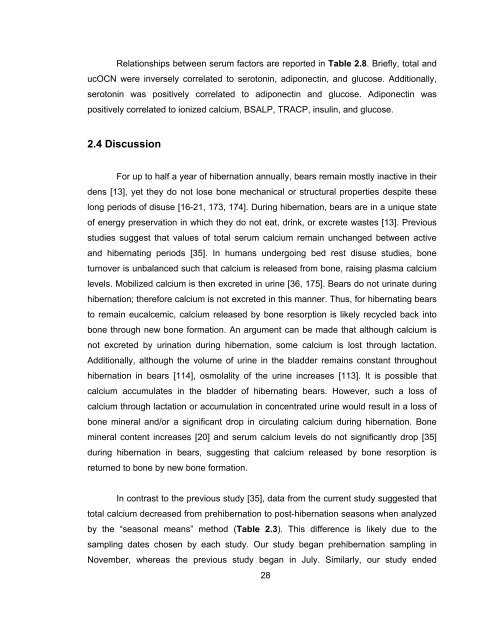C - Michigan Technological University
C - Michigan Technological University
C - Michigan Technological University
- No tags were found...
You also want an ePaper? Increase the reach of your titles
YUMPU automatically turns print PDFs into web optimized ePapers that Google loves.
Relationships between serum factors are reported in Table 2.8. Briefly, total anducOCN were inversely correlated to serotonin, adiponectin, and glucose. Additionally,serotonin was positively correlated to adiponectin and glucose. Adiponectin waspositively correlated to ionized calcium, BSALP, TRACP, insulin, and glucose.2.4 DiscussionFor up to half a year of hibernation annually, bears remain mostly inactive in theirdens [13], yet they do not lose bone mechanical or structural properties despite theselong periods of disuse [16-21, 173, 174]. During hibernation, bears are in a unique stateof energy preservation in which they do not eat, drink, or excrete wastes [13]. Previousstudies suggest that values of total serum calcium remain unchanged between activeand hibernating periods [35]. In humans undergoing bed rest disuse studies, boneturnover is unbalanced such that calcium is released from bone, raising plasma calciumlevels. Mobilized calcium is then excreted in urine [36, 175]. Bears do not urinate duringhibernation; therefore calcium is not excreted in this manner. Thus, for hibernating bearsto remain eucalcemic, calcium released by bone resorption is likely recycled back intobone through new bone formation. An argument can be made that although calcium isnot excreted by urination during hibernation, some calcium is lost through lactation.Additionally, although the volume of urine in the bladder remains constant throughouthibernation in bears [114], osmolality of the urine increases [113]. It is possible thatcalcium accumulates in the bladder of hibernating bears. However, such a loss ofcalcium through lactation or accumulation in concentrated urine would result in a loss ofbone mineral and/or a significant drop in circulating calcium during hibernation. Bonemineral content increases [20] and serum calcium levels do not significantly drop [35]during hibernation in bears, suggesting that calcium released by bone resorption isreturned to bone by new bone formation.In contrast to the previous study [35], data from the current study suggested thattotal calcium decreased from prehibernation to post-hibernation seasons when analyzedby the “seasonal means” method (Table 2.3). This difference is likely due to thesampling dates chosen by each study. Our study began prehibernation sampling inNovember, whereas the previous study began in July. Similarly, our study ended28
















